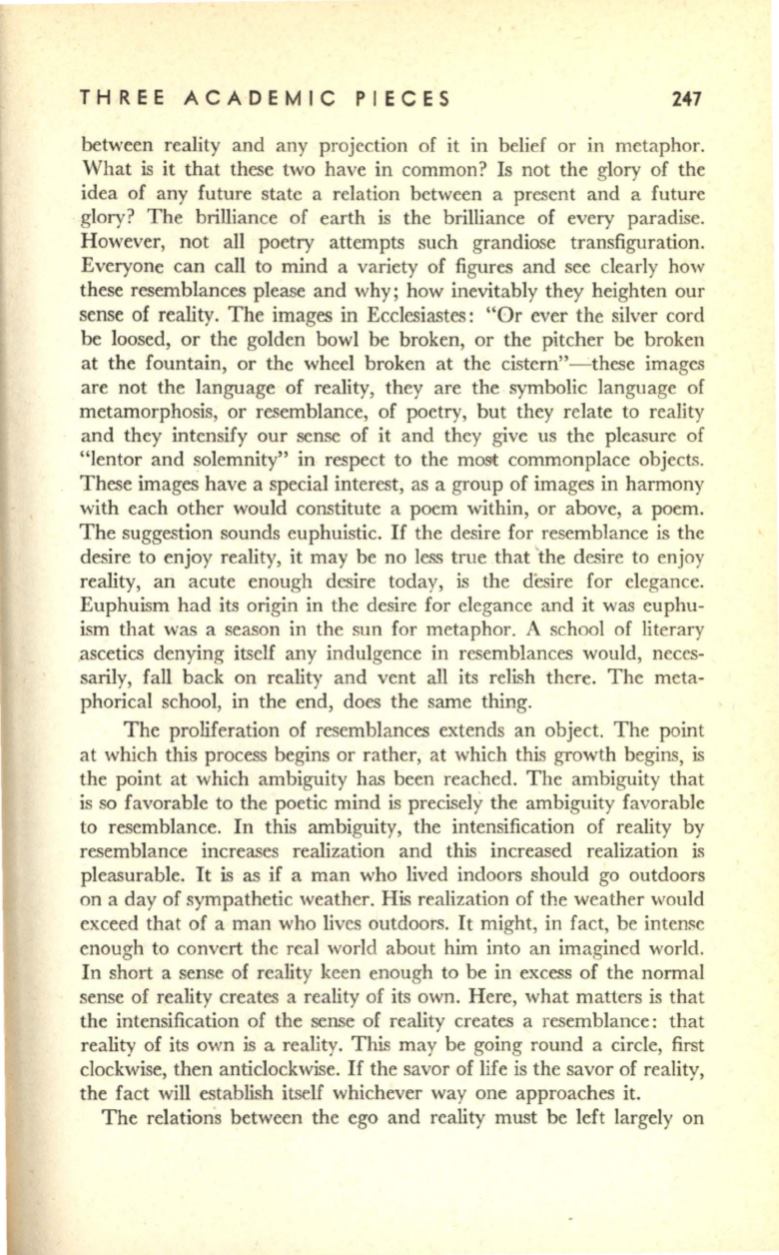
THREE ACADEMIC PIECES
247
between reality and any projection of it in belief or in metaphor.
What is it that these two have in common? Is not the glory of the
idea of any future state a relation between a present and a future
glory? The brilliance of earth is the brilliance of every paradise.
However, not all poetry attempts such grandiose transfiguration.
Everyone can call to mind a variety of figures and see clearly how
these resemblances please and why; how inevitably they heighten our
sense of reality. The images in Ecclesiastes: "Or ever the silver cord
be loosed, or the golden bowl be broken, or the pitcher be broken
at the fountain, or the wheel broken at the cistern"-these images
are not the language of reality, they are the symbolic language of
metamorphosis, or resemblance, of poetry, but they relate to reality
and they intensify our sense of it and they give us the pleasure of
"lentor and solemnity" in respect to the most commonplace objects.
These images have a special interest, as a group of images in harmony
with each other would constitute a poem within, or above, a poem.
The suggestion sounds euphuistic.
If
the desire for resemblance is the
desire to enjoy reality, it may be no less true that 'the desire to enjoy
reality, an acute enough desire today, is the desire for elegance.
Euphuism had its origin in the desire for elegance and it was euphu–
ism that was a season in the sun for metaphor. A school of literary
ascetics denying itself any indulgence in resemblances would, neces–
sarily, fall back on reality and vent all its relish there. The meta–
phorical school, in the end, does the same thing.
The proliferation of resemblances extends an object. The point
at which this process begins or rather, at which this growth begins, is
the point at which ambiguity has been reached. The ambiguity that
is so favorable to the poetic mind is precisely the ambiguity favorable
to resemblance. In this ambiguity, the intensification of reality by
resemblance increases realization and this increased realization is
pleasurable. It is as if a man who lived indoors should go outdoors
on a day of sympathetic weather. His realization of the weather would
exceed that of a man who lives outdoors. It might, in fact, be intense
enough to convert the real world about him into an imagined world.
In short a sense of reality keen enough to be in excess of the normal
sense of reality creates a reality of its own. Here, what matters is that
the intensification of the sense of reality creates a resemblance : that
reality of its own is a reality. This may be going round a circle, first
clockwise, then anticlockwise.
If
the savor of life is the savor of reality,
the fact will establish itself whichever way one approaches it.
The relations between the ego and reality must be left largely on


